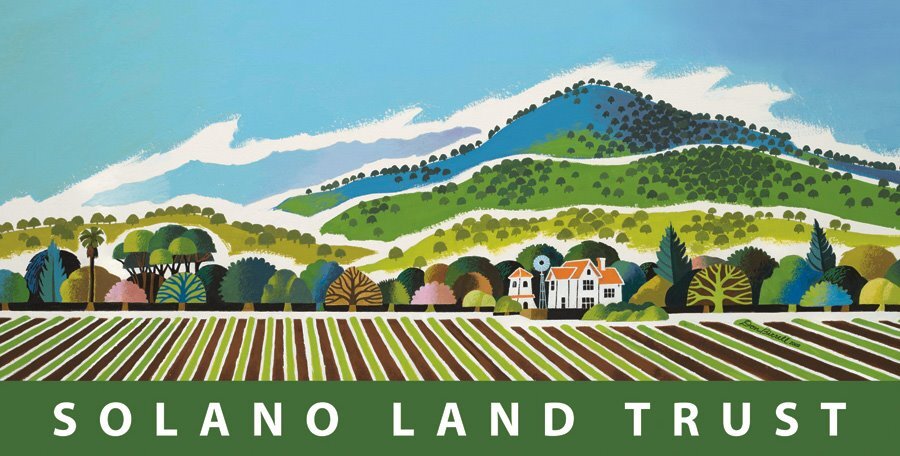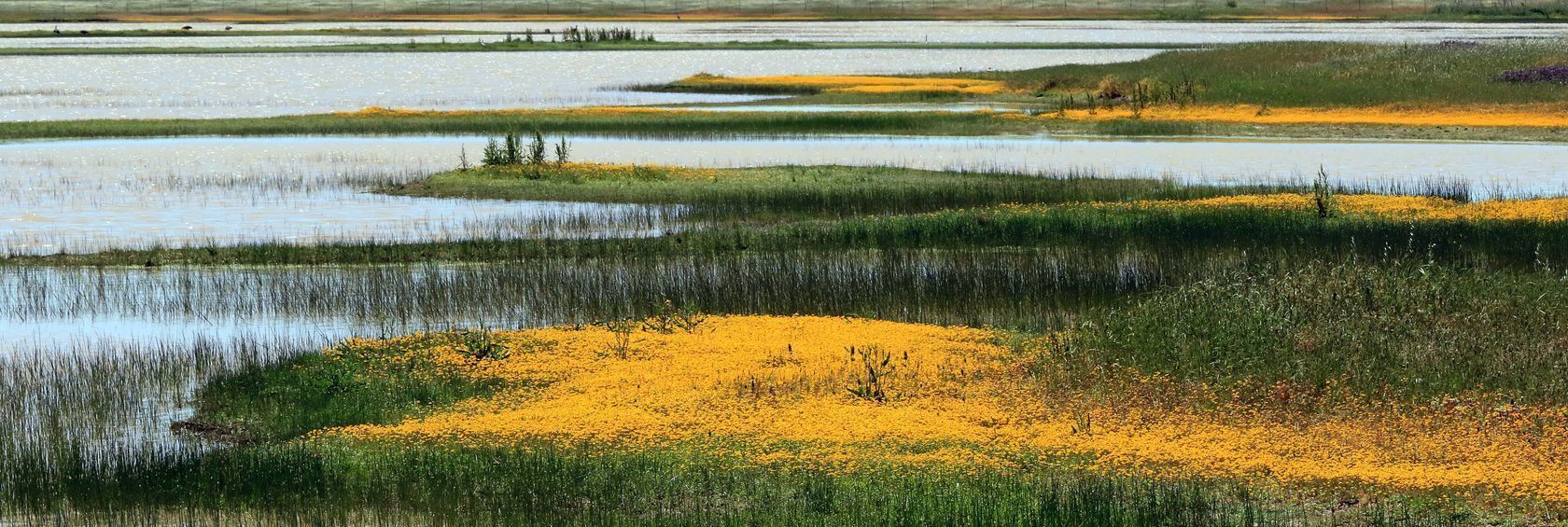Welcome to Jepson Prairie
Jepson Prairie Preserve is one of the best remaining examples of vernal pool ecosystems in California. This unique landscape offers a glimpse into the rare biodiversity that thrives in seasonal wetlands. With its vibrant springtime wildflowers, endangered species, and stunning open spaces, Jepson Prairie is a treasure for nature lovers, scientists, and educators alike.
Managed by Solano Land Trust, the preserve serves as a living laboratory for research and a sanctuary for rare and endangered species, including the California tiger salamander and vernal pool fairy shrimp.
Key Features
-
What is a Vernal Pool?
Every vernal pool starts as a puddle, but not every puddle becomes a vernal pool.
The temporary bodies of water form when an impermeable layer of soil prevents groundwater percolation and traps winter rain in shallow pools. Vernal pools begin to form in winter and dry out by late spring or early summer. Within that window of time, crustaceans will carry out their entire lifecycle before the water evaporates. Organisms that depend on vernal pools are the “obligate species” of vernal pools, and include the crustaceans that live inside cysts beneath the soil as well as the California Tiger Salamanders that live in the uplands. The presence of the organisms in the pools defines vernal pools apart from other temporary bodies of water. (The absence of fish is another notable and crucial characteristic of the pools.)
When a vernal pool grows larger than an acre it is called a playa (after the Spanish word for “beach”). The largest of the playas within the Jepson Prairie Preserve is the 93-acre Olcott Pool, which forms above the whitish, alkaline soil. After this pool evaporates in summer, Alkali Heath and Cressa grow in the soil; the property’s rare native bunchgrasses also grow in soil previously submerged in water.
Vernal pools have formed in the Jepson Prairie region for 50,000 years or longer. The pools and the surrounding landscape support numerous threatened and endangered species, including the Delta green ground beetle, known only from the 10-square-mile area surrounding the preserve. Other endangered, threatened, or rare species include vernal pool fairy shrimp, conservancy fairy shrimp, vernal pool tadpole shrimp, and California tiger salamander. The California Tiger Salamander live in nearby burrows dug by Botta’s Pocket Gophers, breed in the pools, and deposit the young that will grow from larvae into terrestrial animals.
The preserve also provides critical habitat for 400 species of plants, including 15 rare and endangered species such as Bogg’s Lake hedge-hyssop, dwarf Downingia, Baker’s navarretia, Colusa grass, and Solano grass. Some of the preserve’s showiest flowers include Meadowfoam, Goldfields, and Yellow Carpet, which are pollinated by ground-nesting specialist bees in the family Adrenidae.
The great diversity of plant life found at Jepson Prairie Preserve is partly attributable to the diversity of soil types in the ground, including Pescadero Clay, San-Ysidro Sandy Loam, and Solano Loam. Different flowers are adapted to different soils, and areas of land only twenty feet apart may have vastly different blooms growing over them. The Jepson Prairie Preserve Handbook, edited by Carol W. Witham & Kate Mawdsley, contains a soil map along with its many pictures and entries on the plants and animals found at the property.
-
History of Jepson Prairie
Dry and dormant most of the year, the 1,566-acre preserve south of Dixon transforms when winter rainfall collects above claypan depressions in the soil. The vernal pools begin as unassuming puddles, but within months they will host a teeming ecosystem of rare crustaceans and amphibians, and the surrounding uplands will be covered by millions of tiny wildflowers. Some temporary pools are small and clear; others, like the 93-acre Olcott pool, have a muddy color and resemble lakes at their fullest.
Before European settlement, grasslands with spring flowers and vernal pools would have been a common sight for the Native People of California’s vast Central Valley. Today, vernal pools are rare in California. As the population grew and the Central Valley’s 13 million acres were converted into agriculture, over ninety percent of the state’s original habitat vanished.
The Jepson Prairie area was already known as a popular spring flower destination and a scientifically interesting site for its aquatic fauna by the early 1900s. The development of the environmental movement in the 1960s and the recognition of the singular value of the Jepson Prairie vernal pools generated popular support for protecting the area, with special focus paid to the rare Solano and Colusa grasses that grow here.
The Nature Conservancy purchased the 1,566-acre site in 1980, and it was dedicated as the Willis Linn Jepson Prairie Preserve in 1982. The following year, a cooperative agreement brought the preserve into the University of California’s Natural Reserve System. In 1987 the National Park Service designated the Dixon Vernal Pools, of which Jepson is the centerpiece, as a National Natural Landmark. The land was transferred to Solano Land Trust in 1997. The Solano Land Trust also manages nearby Wilcox Ranch, a 1,498-acre preserve containing similar habitat, and holds conservation agreements protecting ranchland and habitat on adjacent lands.
Solano Land Trust has primary responsibility for the management of the land. The Land Trust stewards the property with the goal of preserving, protecting, and enhancing the habitat for native plants and animals. SLT works in partnership with The Nature Conservancy, University of California Natural Reserve System, California Department of Fish and Wildlife, and our dedicated volunteer docents.
Solano Land Trust also partners with a family of ranchers who have grazed cattle and sheep in this part of Solano County for five generations. Today, grazing remains the primary management method at Jepson Prairie Preserve, where native herbivores such as elk and buffalo no longer feed. Sheep consume the invasive European grasses that would otherwise outcompete native grasses and flowers, and potentially shorten the hydroperiod of the pools.
-
Rare Wildlife and Plant Species
Jepson Prairie is home to an array of fascinating flora and fauna. Highlights include:
California Tiger Salamander: An endangered amphibian found in vernal pools.
Vernal Pool Fairy Shrimp: A tiny crustacean unique to seasonal wetlands.
Wildflowers: Fields of goldfields, meadowfoam, and tidy tips bloom in vibrant colors during spring. -
Docent-Led Tours
During the spring, knowledgeable guides lead visitors on tours to explore the preserve’s wonders. Learn about the ecological significance of vernal pools and spot the delicate species that depend on them.
-
Research and Education
Scientists and students alike study Jepson Prairie to better understand California’s vanishing ecosystems. Educational programs provide opportunities to connect with nature and conservation efforts.
Plan Your Visit
Hours of Operation
Open daily, 9am to 5pm.
Guided Wildflower and Critter Walks occur on weekends during the spring.
Directions
Located 10 miles south of Dixon off Highway 113. Parking is available at the main entrance. (View on Google Maps)
Rules and Guidelines
- No pets or bicycles are allowed to protect sensitive habitats.
- Stay on designated trails.
- Guided tours are highly recommended to enhance your visit.
Educational & Conservation Importance
Jepson Prairie Preserve is not only a haven for wildlife but also a cornerstone in preserving California's unique ecosystems. Your visit supports ongoing conservation efforts and fosters a greater understanding of the importance of vernal pools in our environment.
Research at Jepson Prairie
A note to researchers: Jepson Prairie Preserve is an important site of research through an ongoing partnership between Solano Land Trust and the University of California Natural Reserve System. Research applications are available through the NRS Reserve Application Management System (RAMS).
Brochure
Videos
Bay Nature magazine also produced two videos during their public hike at Jepson Prairie in April 2011. Here are the videos featuring Jepson Prairie docents Russ Huddleston and Celia Zavatsky:

